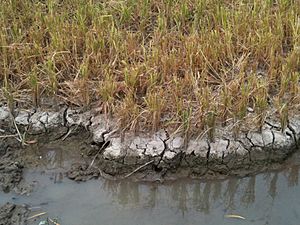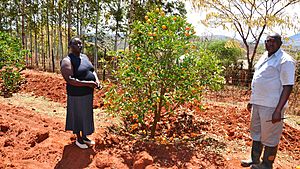Effects of climate change on agriculture facts for kids
The effects of climate change on farming can make it harder to grow food. This is because of things like droughts (not enough rain), heat waves (very hot weather), and floods (too much water). It also means more pests and plant diseases can harm crops.
These changes happen because of global climate change, which makes temperatures rise, rainfall patterns change, and carbon dioxide levels in the air increase.
By 2019, millions of people were already struggling to get enough food because of climate change. Experts predicted that global food production could drop by 2% to 6% every ten years. They also thought food prices might go up by 80% by 2050, which would make it even harder for poorer communities to afford food. A study in 2021 showed that heatwaves and droughts affected crop production three times more severely in Europe over the last 50 years.
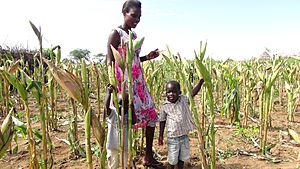
Rising temperatures, heat waves, and changes in rainfall (like droughts and floods) directly impact farming. More carbon dioxide in the air can sometimes make crops grow bigger (this is called the CO2 fertilisation effect). However, it can also make them less nutritious, meaning they have fewer important micronutrients.
Climate change also causes changes in pests, plant diseases, and weeds, which can lead to lower harvests. Other indirect effects include losing farmland to sea level rise. On the bright side, some frozen land might melt, creating more arable land (land that can be farmed). But there will also be less water for irrigation because glaciers are melting.
Climate change can also affect soil fertility and cause erosion. It can change how long plants have to grow and even impact food safety (for example, by increasing harmful fungi and bacteria). All these issues can also create extra financial problems for farmers.
Scientists say that climate change adaptation (ways to adjust to climate change) can help reduce these negative effects on farming. This includes new farming methods, clever ideas, and changes in how farming is organized. These ideas are often part of creating a sustainable food system that helps both people and the planet.
According to a big report from the IPCC in 2022, "Climate change is putting stress on agriculture, forestry, fisheries, and aquaculture, making it harder to meet human needs."
Contents
- How changing weather directly affects farming
- How more CO2 in the air directly affects farming
- How climate change affects pests, plant diseases, and weeds
- Other indirect impacts from changed conditions
- Global estimates for crop yields
- Adaptation: Adjusting to climate change
- Regional impacts
- Contributions of agriculture to climate change
- See also
How changing weather directly affects farming
Rising temperatures
As temperatures and weather patterns change, the best places for farming will shift. Experts predict that major dry and semi-dry areas (like the Middle East, Africa, Australia, and Southern Europe) will get hotter and have less rain.
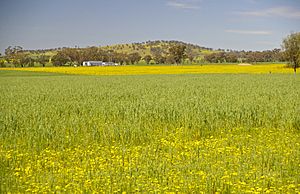
In tropical regions, even a small temperature rise (1-2°C) is expected to harm crop yields in the first half of this century. Later in the century, more warming is likely to reduce crop yields everywhere, even in Canada and the Northern United States. Many important staple crops are very sensitive to heat. For example, soybean seedlings die if temperatures go above 36°C, and corn pollen stops working.
Warmer winters and more frost-free days in some areas could mean longer growing seasons. For instance, a 2014 study found that maize yields in China's Heilongjiang region increased by 7 to 17% each decade because of rising temperatures.
The overall rise in heat has a huge impact on farming. Crops are starting to struggle with common growing habits due to higher temperatures. This also creates more opportunities for dangerous diseases to infect crops.
Heat waves
In the summer of 2018, heat waves, likely linked to climate change, greatly reduced harvests in many parts of the world, especially Europe. These losses were similar to those in 1945, which was one of the worst harvests ever. 2018 was the third time in four years that global wheat, rice, and maize production couldn't meet demand, forcing countries to use up their stored food supplies.
Heat stress on farm animals
Heat stress affects farm animals by impacting their growth, how they reproduce, how much they eat, and how much milk or meat they produce. When temperatures are higher than usual, animals struggle to keep their bodies working normally. This leads to them eating less, being less active, and losing weight. All of this reduces how much they produce.
To help animals with heat stress, farmers should make sure they have easy access to water. They should also feed them during cooler parts of the day and provide shelters with good air circulation. The effects of heat vary depending on the animal's location and species.
Changes in rainfall (including droughts and floods)
Droughts and floods reduce crop yields because extreme weather events are becoming more common due to climate change. In severe cases, floods destroy crops, stop farming activities, leave workers without jobs, and cut off food supplies. Droughts can also wipe out entire crops. In developing countries, droughts make existing poverty worse and lead to famine and malnutrition.
Using irrigation (watering crops) can reduce or even prevent the negative effects of less rainfall and higher temperatures. However, using water for irrigation has downsides and can be expensive. Also, the water has to come from somewhere. If an area has been in a drought for a long time, rivers might be dry, and water would need to be brought from far away.
Droughts are happening more often because of global warming. They are expected to become more frequent and intense in Africa, southern Europe, the Middle East, most of the Americas, Australia, and Southeast Asia. Their effects are made worse by increased water demand, population growth, and the spread of cities. Droughts cause crops to fail and livestock to lose grazing land. Some farmers might even decide to stop farming in drought-affected areas and move elsewhere.
In the early 2000s, floods, likely linked to climate change, shortened the planting season in the Midwest of the United States. This caused damage to the farming sector. In May 2019, floods reduced the expected corn harvest.
How more CO2 in the air directly affects farming
Higher crop yields due to CO2 fertilisation
More carbon dioxide in the air affects plants in several ways. Higher levels of CO2 can increase crop yields and growth because plants can do more photosynthesis. It also means plants lose less water because their stomata (tiny pores on leaves) close more.
Reduced nutritional value of crops
Changes in the air's carbon dioxide levels might reduce how nutritious some crops are. For example, wheat could have less protein and fewer minerals. Food crops might see a 3 to 17% reduction in protein, iron, and zinc content if grown under the carbon dioxide levels expected by 2050.
Studies have shown that plants grown with more CO2 have lower amounts of important micronutrients. This includes less B vitamins in rice. This could also affect other parts of ecosystems, as plant-eating animals would need to eat more food to get the same amount of protein.
Drought stress in Africa, caused by climate change, will likely reduce the nutritional quality of common beans. This would mainly affect people in poorer countries who can't easily make up for it by eating more food or taking supplements.
How climate change affects pests, plant diseases, and weeds
Global warming will change where pests, plant diseases, and weeds live. This could reduce crop yields, even for important foods like wheat, soybeans, and corn.
Pest insects
Currently, plant diseases and pests destroy 10-16% of the global harvest. This amount is likely to increase as plants face more risks from pests and pathogens. Warmer temperatures can speed up the metabolic rate and increase the number of breeding cycles for insect populations. Insects that used to have only two breeding cycles per year could gain an extra cycle if warm growing seasons last longer, leading to a huge increase in their numbers.
Studies show that when CO2 levels rise, soybean leaves become less nutritious. This means plant-eating beetles have to eat more to get the nutrients they need. Also, soybeans are less able to defend themselves against predatory insects when CO2 is high. The CO2 reduces the plant's production of jasmonic acid, a natural poison that the plant releases when attacked by insects. Without this protection, beetles can eat soybean leaves freely, leading to lower crop yields. This problem isn't just for soybeans; many plants' defense systems are weakened in high CO2 environments.
Historically, cold temperatures in winter would kill off insects, bacteria, and fungi. But warmer, wetter winters are now helping fungal plant diseases like wheat rusts and soybean rust spread northward. Soybean rust is a dangerous plant disease that can destroy entire fields in days, costing farmers billions. Another example is the Mountain pine beetle outbreak in British Columbia, Canada. Millions of pine trees died because the winters weren't cold enough to slow down or kill the growing beetle larvae.
More floods and heavy rains also encourage the growth of various other plant pests and diseases. On the other hand, drought conditions favor different kinds of pests like aphids, whiteflies, and locusts.
Locusts
When climate change brings hotter, wetter weather, it can lead to more damaging locust swarms. This happened, for example, in some East African nations in early 2020.
Fall armyworms
The fall armyworm, Spodoptera frugiperda, is a very harmful plant pest that has recently spread to countries in Sub-Saharan Africa. Experts believe its spread is linked to climate change, as climate change is bringing more crop pests to Africa. These pests are expected to spread to other parts of the world because they can adapt to different environments. The fall armyworm can cause massive damage to crops, especially maize, which hurts farming productivity.
Weeds, invasive species, and plant diseases
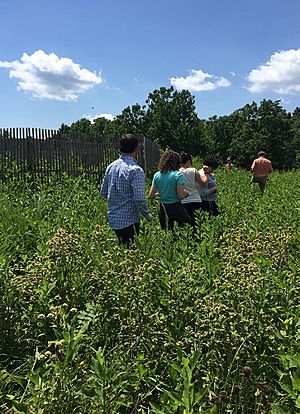
Weeds also grow faster with more CO2, just like crops. Since most weeds are C3 plants, they might compete even more strongly against C4 crops like corn. However, weedkillers might become more effective as temperatures rise.
Global warming could cause more rainfall in some areas, leading to more humidity and longer wet seasons. Combined with higher temperatures, this could help fungal diseases develop. Similarly, there could be more pressure from insects and disease vectors. Climate change can alter how diseases interact with host plants, specifically affecting infection rates and the plant's resistance. Plant diseases also bring economic costs, as farmers might grow less profitable plants or spend more on treating diseased crops.
Research shows that climate change can change the way plant pathogens develop, which affects crops. Changes in weather patterns and temperature due to climate change help plant pathogens spread as their hosts move to areas with better conditions. This increases crop losses due to diseases.
A changing climate might favor the more diverse weeds over the single crops most farms grow. Weeds have traits like genetic diversity, the ability to cross-breed, and fast growth rates. These traits give them an advantage in changing climates, allowing them to adapt easily compared to most farm crops, which are all the same.
With increased CO2 levels, herbicides will become less effective, which means weeds will become more tolerant to them.
Other indirect impacts from changed conditions
Food security and food prices
It's hard to predict exactly how climate change will affect how we use food (like protecting it from spoiling or being healthy enough to absorb nutrients) and how much food prices will change. Most models suggest that prices will become more unpredictable.
In 2019, the IPCC said that millions of people were already struggling with food insecurity because of climate change. As of 2019, about 831 million people were undernourished (not getting enough food). The effects of climate change depend a lot on how society and the economy develop in the future.
A 2019 study showed that climate change has already increased the risk of food insecurity in many countries that already struggle with food.
The IPCC Sixth Assessment Report in 2022 found that: "Climate change will increase the loss of healthy years by 10% in 2050 due to not enough food and lack of important nutrients."
Increasing food prices
According to the IPCC's Special Report on Climate Change and Land, food prices could rise by 80% by 2050, which would likely lead to food shortages. These shortages will affect poorer parts of the world much more than richer ones.
Under a scenario with high emissions, cereals are expected to become 1–29% more expensive by 2050. This would especially affect people with low incomes. Compared to a world without climate change, this could put between 1 and 181 million more people at risk of hunger.
Higher food production costs
With more costs for farmers, some will find it too expensive to continue farming. Agriculture employs most people in many low-income countries. Increased costs can lead to job losses or pay cuts for workers. Other farmers will respond by raising their food prices, which directly affects consumers and makes food less affordable. Some farms don't sell their produce but instead feed a family or community. Without that food, people won't have enough to eat. This leads to less food production, higher food prices, and potential starvation in some parts of the world.
Farmland loss from sea level rise
A rise in the sea level would cause a loss of farmland, especially in areas like Southeast Asia. Erosion, the submergence of shorelines, and salty water tables due to higher sea levels could mainly affect farming by flooding low-lying lands.
Low-lying areas like Bangladesh, India, and Vietnam will lose a lot of rice crops if sea levels rise as expected by the end of the century. Vietnam, for example, relies heavily on its southern tip, where the Mekong Delta is, for growing rice. A one-meter rise in sea level would cover many square kilometers of rice paddies in Vietnam.
More farmable land due to less frozen land
Climate change might increase the amount of arable land by reducing the amount of frozen land. A 2005 study reported that temperatures in Siberia have increased by an average of three degrees Celsius since 1960 (much more than the rest of the world). However, reports about global warming's impact on Russian farming show mixed effects: while they expect farmable lands to extend northward, they also warn of possible drops in productivity and increased risk of drought.
The Arctic region is expected to benefit from more opportunities for farming and forestry.
Less irrigation water from melting glaciers
Some regions depend heavily on water runoff from glaciers that melt during the warmer summer months. So, if glaciers continue to melt as they are now, they will eventually shrink or disappear. This will reduce or eliminate the water runoff. Less runoff will affect the ability to irrigate crops and will reduce summer stream flows needed to keep dams and reservoirs full.
In Asia, a global warming of 1.5°C will reduce the ice mass of Asia's high mountains by about 29-43%. This will affect communities that rely on glacier and snow-melt waters for their livelihoods. In the Indus River watershed, these mountain water resources provide up to 60% of irrigation outside the monsoon season and an additional 11% of total crop production. About 2.4 billion people live in the drainage basin of the Himalayan rivers. In India alone, the river Ganges provides water for drinking and farming for more than 500 million people.
Erosion and soil fertility
The warmer air temperatures seen over the past decades are expected to lead to a more active water cycle, including more extreme rainfall events. Erosion and soil degradation are more likely to happen. Soil fertility would also be affected by global warming. Increased erosion in farm landscapes from human activities can cause losses of up to 22% of soil carbon in 50 years.
Climate change will also cause soils to warm. This, in turn, could cause the soil microbe population to increase dramatically by 40–150%. Warmer conditions would favor the growth of certain bacteria species, changing the bacterial community. More carbon dioxide would increase the growth rates of plants and soil microbes, slowing the soil carbon cycle.
Early blooms and effects on growing periods
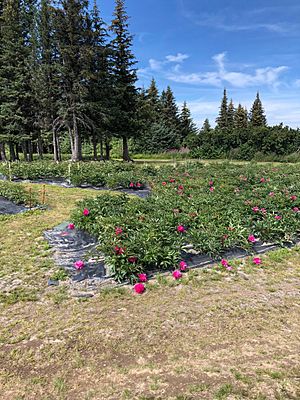
As a result of global warming, flowering times have come earlier. Early blooms can threaten the plants' survival and ability to reproduce. Early flowering increases the risk of frost damage for some plant species and can lead to "mismatches" between when plants flower and when pollinators are active. About 70% of the world's most produced crops rely on insect pollination to some extent.
Also, warmer winter temperatures cause many flowering plants to blossom, because plants usually need a long winter chill to be stimulated to flower. If a plant doesn't flower, it can't reproduce. If winters keep getting milder, plants might not get cold enough to notice the difference when warmer springtime temperatures begin.
The length of a crop's growth cycles is mainly related to temperature. An increase in temperature will speed up development. For an annual crop, the time between sowing (planting) and harvesting will shorten. For example, the time to harvest corn could shorten by one to four weeks. This shortening of the cycle could negatively affect how much is produced because the plant would age faster.
Changes in when crops grow and develop (called phenology) show how they respond to recent regional climate change. A significant shift in phenology has been seen for farming and forestry in large parts of the Northern Hemisphere.
Food safety and losses
It is expected that there will be more food safety problems and losses caused by fungi (leading to mycotoxins) and bacteria (like Salmonella) that increase with climate warming.
Financial burden
Many of the predicted climate scenarios suggest a huge financial burden. For example, the 2003 European heat wave cost 13 billion euros in uninsured farming losses. Also, during El Nino weather conditions, the chance of an Australian farmer's income falling below average increased by 75%, greatly affecting the country's economy.
The farming industry in India employs 52% of its population, and the Canadian Prairies supply 51% of Canadian farming. Any changes in food crop production from these areas could have big effects on the economy. This could negatively affect how affordable food is and the health of the population.
Global estimates for crop yields
Climate change, caused by increasing greenhouse gases, is likely to affect different crops and countries differently. The Intergovernmental Panel on Climate Change (IPCC) has published several reports assessing the scientific information on climate change. In 2019, the IPCC stated that millions already suffer from food insecurity due to climate change and predicted a global crop production decline of 2% to 6% per decade. A 2021 study estimated that the severity of heatwave and drought impacts on crop production tripled over the last 50 years in Europe.
As of 2019, negative impacts have been seen for some crops in low-latitude areas (like maize and wheat). However, positive impacts of climate change have been observed for some crops in high-latitude areas (maize, wheat, and sugar beets). Using different ways to predict future crop yields, a consistent picture shows global decreases in yield. Maize and soybean yields decrease with any warming, while rice and wheat production might reach their peak at 3°C of warming.
A 2019 study tracked about 20,000 political units globally for 10 crops. It found that crop yields across Europe, Sub-Saharan Africa, and Australia had generally decreased because of climate change. However, there were exceptions. The impact of global climate change on yields of different crops ranged from -13.4% (oil palm) to 3.5% (soybean). The study also showed that impacts are generally positive in Latin America. Impacts in Asia and Northern and Central America are mixed.
Adaptation: Adjusting to climate change
Changes in farming practices
Farmers often make their own decisions to adapt to the situations they face, rather than waiting for policies. Changes in how farms are managed might be the most important way to adapt. Moving farming locations and international trade in food could also help with adaptation.
New ideas in farming
New ideas in farming are crucial for dealing with the potential problems of climate change. This includes better ways to manage soil, technology that saves water, choosing the right crops for different environments, introducing new crop types, rotating crops, using fertilization properly, and supporting community-based adaptation plans.
At a government and global level, research and investments in agricultural productivity and infrastructure are needed to better understand the issues and find the best solutions. Governments should provide environmentally friendly subsidies, educational campaigns, and financial incentives. They also need to provide funds, insurance, and safety nets for vulnerable people. Additionally, providing early warning systems and accurate weather forecasts to poor or remote areas will help them prepare better.
Institutional changes
Just focusing on farming technology won't be enough. Work is being done to allow and fund changes in how farming institutions operate, and to create flexible policies for long-term climate change adaptation in farming.
A 2013 study aimed to find scientific, poverty-reducing ways to help Asia's farming systems cope with climate change, while also benefiting poor farmers. The study suggested things like using climate information better in local planning, improving weather-based advice for farmers, helping rural families earn money in different ways, and encouraging farmers to protect natural resources to increase forest cover, refill groundwater, and use renewable energy.
Climate-smart agriculture
Examples of adapting specific crops
Adapting potato production
Changing potato farming methods and potato types to suit new conditions caused by climate change could help keep harvests steady. It could also allow potatoes to be grown in areas where current potato types wouldn't survive. Ways to adapt potatoes include moving production areas, improving water use, and breeding new potato types that can handle tough conditions.
Potato yields are expected to decrease in some areas (like Sub-Saharan Africa) but increase in others (like northern Russia). This is mostly due to changes in water and temperature. At the same time, potato production might become possible in high-altitude and high-latitude areas where frost damage used to prevent it. These changes mean that the areas where potatoes can be grown successfully will shift.
In some countries, yield reductions caused by higher temperatures and less water could largely be avoided by moving potato production areas. A potential problem with shifting potato production is that it might compete for land with other crops or other land uses.
Two main ways are used to create new potato types: traditional plant breeding and genetic modification. These methods can play an important role in creating new types that can keep yields high under the stresses caused by climate change.
Traits that could help reduce negative climate impacts on potato production include:
- Heat stress tolerance: The ability to keep growing tubers (the potatoes themselves) even in high temperatures. Developing potato types that can handle more heat is very important for maintaining yields in countries where current potato types are already at their temperature limit (like Sub-Saharan Africa and India).
- Drought tolerance: This means using water more efficiently (producing more food with less water) and having potatoes that can survive short droughts and still produce good yields. Deeper root systems could also help, as most commercial potato types need frequent watering because their roots are shallow.
- Fast growth/early maturation: Potatoes that grow faster could help adjust to shorter growing seasons in some areas. They could also reduce the number of times pests like the potato tuber moth can complete their life cycle in one growing season.
- Disease resistance: Potatoes that are resistant to local pests and diseases could be helpful, especially for adapting to diseases spreading into new areas.
Potatoes
Climate change is expected to have big effects on global potato production. Like many crops, potatoes will likely be affected by changes in air carbon dioxide, temperature, and rainfall, as well as how these factors interact. Besides directly affecting potatoes, climate change will also impact where many potato diseases and pests live and how many there are. Potatoes are one of the world's most important food crops. If farmers and potato types can't adapt to the new environment, worldwide potato yields could be 18-32% lower than they are now.
Potato plants and potato crop yields are expected to benefit from more carbon dioxide in the air. The main benefit of increased atmospheric carbon dioxide for potatoes (and other plants) is that their photosynthetic rates increase, which can make them grow faster. Potato crop yields are also expected to benefit because potatoes put more starch into their edible tubers when carbon dioxide levels are high.
Higher levels of carbon dioxide also mean potatoes don't have to open their stomata as much to take in the same amount of carbon dioxide for photosynthesis. This means less water is lost through transpiration from the stomata. As a result, the water use efficiency (how much carbon is taken in per unit of water lost) of potato plants is expected to increase.
Potatoes grow best in moderate temperatures. Tuber growth and yield can be severely reduced by temperatures outside 5-30°C. The effect of increased temperatures on potato production in specific areas will vary depending partly on the current temperature of that area. Temperatures above 30°C can have several negative effects on potatoes, including:
- Slowing tuber growth.
- Less starch going to the tubers.
- Damage to tubers (like brown spots).
- Shortened or non-existent tuber dormancy, causing tubers to sprout too early.
These effects can reduce how much is harvested and the number and weight of potatoes. As a result, areas where current temperatures are near the limits of what potatoes can handle (like much of Sub-Saharan Africa) will likely see big reductions in potato crop yields in the future.
At low temperatures, potatoes are at risk of frost damage, which can reduce growth and badly damage tubers. In areas where potato growth is currently limited or impossible due to frost risk (like at high altitudes and in high-latitude countries such as Russia and Canada), rising temperatures will likely benefit potato crops by extending the growing season and increasing potential potato growing land.
Potatoes are sensitive to dry soil compared to other crops like wheat, and they need frequent watering, especially when tubers are growing. Less rainfall in many areas is expected to increase the need for watering potato crops. For example, in the UK, the amount of arable land suitable for rainfed potato production is expected to decrease by at least 75%. Besides overall reductions in rainfall, potato crops also face challenges from changing seasonal rainfall patterns. For example, in Bolivia, the rainy season has shortened in recent decades, leading to a shorter potato growing season.
Changes in pests and diseases for potato crops
Climate change is expected to affect many potato pests and diseases. These include:
- Insect pests like the potato tuber moth and Colorado potato beetle, which are predicted to spread into areas currently too cold for them.
- Aphids, which carry many potato viruses, will also be able to spread with increased temperatures.
- Several pathogens causing potato blackleg disease can grow and reproduce faster at higher temperatures, so they will likely become more of a problem.
- Bacterial infections like Ralstonia solanacearum are predicted to benefit from higher temperatures and spread more easily through flash flooding.
- Late blight benefits from higher temperatures and wetter conditions. Late blight is predicted to become a greater threat in some areas (like Finland) and less of a threat in others (like the United Kingdom).
Regional impacts
Africa
Asia
In East and Southeast Asia, the IPCC predicted in 2007 that crop yields could increase by up to 20% by the mid-21st century. In Central and South Asia, predictions suggested that yields might decrease by up to 30% over the same period.
Different Asian countries will experience various impacts from climate change. China, for example, might benefit from a 1.5°C temperature increase with carbon fertilization, leading to a 3% gain of US$18 billion per year. However, India will face two-thirds of the total losses in farming because its high crop income suffers from high spring temperatures.
Due to climate change, livestock production will decrease in Bangladesh because of diseases, lack of food, heat stress, and breeding challenges.
Australia and New Zealand
Without more efforts to adapt to climate change, the expected impacts would likely be significant. By 2030, farming and forestry production was predicted to decline over much of southern and eastern Australia, and parts of eastern New Zealand. In New Zealand, initial benefits were expected near major rivers and in western and southern areas.
Europe
The IPCC predicted in 2007 with high confidence that in Southern Europe, climate change would reduce crop productivity. In Central and Eastern Europe, forest productivity was expected to decline. In Northern Europe, the initial effect of climate change was predicted to increase crop yields. A 2019 report confirmed this, stating that yields of non-irrigated crops like wheat, corn, and sugar beet would decrease in southern Europe by up to 50% by 2050 (under a high-emission scenario). This could lead to a big drop in farm income. Farmland values are also expected to decrease in parts of southern Europe by more than 80% by 2100, which could lead to land being abandoned. Trade patterns are also expected to be affected, which in turn impacts farming income. Also, increased global food demand could put pressure on food prices in the coming decades.
Latin America
The main farm products of Latin America include livestock and grains like maize, wheat, soybeans, and rice. Higher temperatures and changed water cycles are expected to lead to shorter growing seasons, less overall plant growth, and lower grain yields. Brazil, Mexico, and Argentina alone produce 70-90% of all farm products in Latin America. In these and other dry regions, maize production is expected to decrease. A study summarizing several impact studies on farming in Latin America indicated that wheat is expected to decrease in Brazil, Argentina, and Uruguay. Livestock, which is the main farm product for parts of Argentina, Uruguay, southern Brazil, Venezuela, and Colombia, is likely to be reduced.
Increased rainfall variability has been one of the most damaging results of climate change in Central America and Mexico. From 2009 to 2019, the region saw years of heavy rainfall mixed with years of below-average rainfall. The spring rains in May and June have been especially unpredictable, causing problems for farmers who plant their maize crops at the start of the spring rains. Most small-scale farmers in the region don't have irrigation and rely on the rains for their crops to grow. In Mexico, only 21% of farms are irrigated, leaving the remaining 79% dependent on rainfall.
Suggested ways to adapt and reduce the impacts of global warming on farming in Latin America include using plant breeding technologies and installing irrigation systems.
North America
Droughts are becoming more frequent and intense in dry and semiarid western North America as temperatures have been rising. This causes spring snowmelt floods to happen earlier and be larger, and reduces river flow in summer. Direct effects of climate change include more heat and water stress, changes in when crops grow, and disrupted natural interactions. These effects may be made worse by climate changes in river flow. The combined effects are likely to reduce the number of native trees in favor of non-native herbaceous plants and drought-tolerant competitors. They will also reduce habitat quality for many native animals and slow down the breakdown of plant matter and nutrient cycling in the soil. Climate change effects on human water demand and irrigation may make these problems worse.
Contributions of agriculture to climate change
See also
 In Spanish: Cambio climático y agricultura para niños
In Spanish: Cambio climático y agricultura para niños


